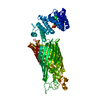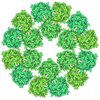+ Open data
Open data
- Basic information
Basic information
| Entry |  | |||||||||
|---|---|---|---|---|---|---|---|---|---|---|
| Title | Cryo-EM map of the E. coli cellulose synthase BcsAG3B6 complex | |||||||||
 Map data Map data | Composite structure: Composite map reconstructed from focussed refinement of BcsAG3 and BcsB6 | |||||||||
 Sample Sample |
| |||||||||
 Keywords Keywords | phosphoethanolamine (pEtN) / catalytic BcsA-B / c-di-GMP binding protein / membrane proteins / TRANSFERASE | |||||||||
| Function / homology |  Function and homology information Function and homology informationbacterial cellulose biosynthetic process / cellulose synthase (UDP-forming) / cellulose synthase (UDP-forming) activity / cellulose biosynthetic process / UDP-alpha-D-glucose metabolic process / hexosyltransferase activity / cyclic-di-GMP binding / plasma membrane Similarity search - Function | |||||||||
| Biological species |  | |||||||||
| Method | single particle reconstruction / cryo EM / Resolution: 4.0 Å | |||||||||
 Authors Authors | Verma P / Zimmer J | |||||||||
| Funding support |  United States, 1 items United States, 1 items
| |||||||||
 Citation Citation |  Journal: Nat Commun / Year: 2024 Journal: Nat Commun / Year: 2024Title: Insights into phosphoethanolamine cellulose synthesis and secretion across the Gram-negative cell envelope. Authors: Preeti Verma / Ruoya Ho / Schuyler A Chambers / Lynette Cegelski / Jochen Zimmer /  Abstract: Phosphoethanolamine (pEtN) cellulose is a naturally occurring modified cellulose produced by several Enterobacteriaceae. The minimal components of the E. coli cellulose synthase complex include the ...Phosphoethanolamine (pEtN) cellulose is a naturally occurring modified cellulose produced by several Enterobacteriaceae. The minimal components of the E. coli cellulose synthase complex include the catalytically active BcsA enzyme, a hexameric semicircle of the periplasmic BcsB protein, and the outer membrane (OM)-integrated BcsC subunit containing periplasmic tetratricopeptide repeats (TPR). Additional subunits include BcsG, a membrane-anchored periplasmic pEtN transferase associated with BcsA, and BcsZ, a periplasmic cellulase of unknown biological function. While cellulose synthesis and translocation by BcsA are well described, little is known about its pEtN modification and translocation across the cell envelope. We show that the N-terminal cytosolic domain of BcsA positions three BcsG copies near the nascent cellulose polymer. Further, the semicircle's terminal BcsB subunit tethers the N-terminus of a single BcsC protein in a trans-envelope secretion system. BcsC's TPR motifs bind a putative cello-oligosaccharide near the entrance to its OM pore. Additionally, we show that only the hydrolytic activity of BcsZ but not the subunit itself is necessary for cellulose secretion, suggesting a secretion mechanism based on enzymatic removal of translocation incompetent cellulose. Lastly, protein engineering introduces cellulose pEtN modification in orthogonal cellulose biosynthetic systems. These findings advance our understanding of pEtN cellulose modification and secretion. | |||||||||
| History |
|
- Structure visualization
Structure visualization
| Supplemental images |
|---|
- Downloads & links
Downloads & links
-EMDB archive
| Map data |  emd_44359.map.gz emd_44359.map.gz | 159.2 MB |  EMDB map data format EMDB map data format | |
|---|---|---|---|---|
| Header (meta data) |  emd-44359-v30.xml emd-44359-v30.xml emd-44359.xml emd-44359.xml | 18.4 KB 18.4 KB | Display Display |  EMDB header EMDB header |
| FSC (resolution estimation) |  emd_44359_fsc.xml emd_44359_fsc.xml | 16.5 KB | Display |  FSC data file FSC data file |
| Images |  emd_44359.png emd_44359.png | 146.5 KB | ||
| Filedesc metadata |  emd-44359.cif.gz emd-44359.cif.gz | 7.3 KB | ||
| Archive directory |  http://ftp.pdbj.org/pub/emdb/structures/EMD-44359 http://ftp.pdbj.org/pub/emdb/structures/EMD-44359 ftp://ftp.pdbj.org/pub/emdb/structures/EMD-44359 ftp://ftp.pdbj.org/pub/emdb/structures/EMD-44359 | HTTPS FTP |
-Validation report
| Summary document |  emd_44359_validation.pdf.gz emd_44359_validation.pdf.gz | 548.8 KB | Display |  EMDB validaton report EMDB validaton report |
|---|---|---|---|---|
| Full document |  emd_44359_full_validation.pdf.gz emd_44359_full_validation.pdf.gz | 548.3 KB | Display | |
| Data in XML |  emd_44359_validation.xml.gz emd_44359_validation.xml.gz | 13.4 KB | Display | |
| Data in CIF |  emd_44359_validation.cif.gz emd_44359_validation.cif.gz | 18.1 KB | Display | |
| Arichive directory |  https://ftp.pdbj.org/pub/emdb/validation_reports/EMD-44359 https://ftp.pdbj.org/pub/emdb/validation_reports/EMD-44359 ftp://ftp.pdbj.org/pub/emdb/validation_reports/EMD-44359 ftp://ftp.pdbj.org/pub/emdb/validation_reports/EMD-44359 | HTTPS FTP |
-Related structure data
| Related structure data |  9b8vMC  9b87C  9b8aC  9b8hC  9b8iC C: citing same article ( M: atomic model generated by this map |
|---|---|
| Similar structure data | Similarity search - Function & homology  F&H Search F&H Search |
- Links
Links
| EMDB pages |  EMDB (EBI/PDBe) / EMDB (EBI/PDBe) /  EMDataResource EMDataResource |
|---|---|
| Related items in Molecule of the Month |
- Map
Map
| File |  Download / File: emd_44359.map.gz / Format: CCP4 / Size: 178 MB / Type: IMAGE STORED AS FLOATING POINT NUMBER (4 BYTES) Download / File: emd_44359.map.gz / Format: CCP4 / Size: 178 MB / Type: IMAGE STORED AS FLOATING POINT NUMBER (4 BYTES) | ||||||||||||||||||||||||||||||||||||
|---|---|---|---|---|---|---|---|---|---|---|---|---|---|---|---|---|---|---|---|---|---|---|---|---|---|---|---|---|---|---|---|---|---|---|---|---|---|
| Annotation | Composite structure: Composite map reconstructed from focussed refinement of BcsAG3 and BcsB6 | ||||||||||||||||||||||||||||||||||||
| Projections & slices | Image control
Images are generated by Spider. | ||||||||||||||||||||||||||||||||||||
| Voxel size | X=Y=Z: 1.08 Å | ||||||||||||||||||||||||||||||||||||
| Density |
| ||||||||||||||||||||||||||||||||||||
| Symmetry | Space group: 1 | ||||||||||||||||||||||||||||||||||||
| Details | EMDB XML:
|
-Supplemental data
- Sample components
Sample components
-Entire : Bacterial cellulose synthase BcsA-BcsG3-BcsB6 complex
| Entire | Name: Bacterial cellulose synthase BcsA-BcsG3-BcsB6 complex |
|---|---|
| Components |
|
-Supramolecule #1: Bacterial cellulose synthase BcsA-BcsG3-BcsB6 complex
| Supramolecule | Name: Bacterial cellulose synthase BcsA-BcsG3-BcsB6 complex / type: complex / ID: 1 / Parent: 0 / Macromolecule list: all Details: Proteins: 1. Bacterial cellulose synthase subunit A (BcsA) 2. Bacterial cellulose synthase subunit B (BcsB) 3. Bacterial cellulose synthase subunit G (BcsG) |
|---|---|
| Source (natural) | Organism:  |
-Macromolecule #1: Cellulose synthase operon protein B
| Macromolecule | Name: Cellulose synthase operon protein B / type: protein_or_peptide / ID: 1 / Number of copies: 6 / Enantiomer: LEVO |
|---|---|
| Source (natural) | Organism:  |
| Molecular weight | Theoretical: 84.375984 KDa |
| Recombinant expression | Organism:  |
| Sequence | String: AWSHPQFEKT PATQPLINAE PAVAAQTEQN PQVGQVMPGV QGADAPVVAQ NGPSRDVKLT FAQIAPPPGS MVLRGINPNG SIEFGMRSD EVVTKAMLNL EYTPSPSLLP VQSQLKVYLN DELMGVLPVT KEQLGKKTLA QMPINPLFIS DFNRVRLEFV G HYQDVCEK ...String: AWSHPQFEKT PATQPLINAE PAVAAQTEQN PQVGQVMPGV QGADAPVVAQ NGPSRDVKLT FAQIAPPPGS MVLRGINPNG SIEFGMRSD EVVTKAMLNL EYTPSPSLLP VQSQLKVYLN DELMGVLPVT KEQLGKKTLA QMPINPLFIS DFNRVRLEFV G HYQDVCEK PASTTLWLDV GRSSGLDLTY QTLNVKNDLS HFPVPFFDPS DNRTNTLPMV FAGAPDVGLQ QASAIVASWF GS RSGWRGQ NFPVLYNQLP DRNAIVFATN DKRPDFLRDH PAVKAPVIEM INHPQNPYVK LLVVFGRDDK DLLQAAKGIA QGN ILFRGE SVVVNEVKPL LPRKPYDAPN WVRTDRPVTF GELKTYEEQL QSSGLEPAAI NVSLNLPPDL YLMRSTGIDM DINY RYTMP PVKDSSRMDI SLNNQFLQSF NLSSKQEANR LLLRIPVLQG LLDGKTDVSI PALKLGATNQ LRFDFEYMNP MPGGS VDNC ITFQPVQNHV VIGDDSTIDF SKYYHFIPMP DLRAFANAGF PFSRMADLSQ TITVMPKAPN EAQMETLLNT VGFIGA QTG FPAINLTVTD DGSTIQGKDA DIMIIGGIPD KLKDDKQIDL LVQATESWVK TPMRQTPFPG IVPDESDRAA ETRSTLT SS GAMAAVIGFQ SPYNDQRSVI ALLADSPRGY EMLNDAVNDS GKRATMFGSV AVIRESGINS LRVGDVYYVG HLPWFERV W YALANHPILL AVLAAISVIL LAWVLWRLLR IISRRRLNPD NE UniProtKB: Cyclic di-GMP-binding protein |
-Macromolecule #2: Cellulose biosynthesis protein BcsG
| Macromolecule | Name: Cellulose biosynthesis protein BcsG / type: protein_or_peptide / ID: 2 / Number of copies: 3 / Enantiomer: LEVO |
|---|---|
| Source (natural) | Organism:  |
| Molecular weight | Theoretical: 63.079508 KDa |
| Recombinant expression | Organism:  |
| Sequence | String: MTQFTQNTAM PSSLWQYWRG LSGWNFYFLV KFGLLWAGYL NFHPLLNLVF AAFLLMPLPR YSLHRLRHWI ALPIGFALFW HDTWLPGPE SIMSQGSQVA GFSTDYLIDL VTRFINWQMI GAIFVLLVAW LFLSQWIRIT VFVVAILLWL NVLTLAGPSF S LWPAGQPT ...String: MTQFTQNTAM PSSLWQYWRG LSGWNFYFLV KFGLLWAGYL NFHPLLNLVF AAFLLMPLPR YSLHRLRHWI ALPIGFALFW HDTWLPGPE SIMSQGSQVA GFSTDYLIDL VTRFINWQMI GAIFVLLVAW LFLSQWIRIT VFVVAILLWL NVLTLAGPSF S LWPAGQPT TTVTTTGGNA AATVAATGGA PVVGDMPAQT APPTTANLNA WLNNFYNAEA KRKSTFPSSL PADAQPFELL VI NICSLSW SDIEAAGLMS HPLWSHFDIE FKNFNSATSY SGPAAIRLLR ASCGQTSHTN LYQPANNDCY LFDNLSKLGF TQH LMMGHN GQFGGFLKEV RENGGMQSEL MDQTNLPVIL LGFDGSPVYD DTAVLNRWLD VTEKDKNSRS ATFYNTLPLH DGNH YPGVS KTADYKARAQ KFFDELDAFF TELEKSGRKV MVVVVPEHGG ALKGDRMQVS GLRDIPSPSI TDVPVGVKFF GMKAP HQGA PIVIEQPSSF LAISDLVVRV LDGKIFTEDN VDWKKLTSGL PQTAPVSENS NAVVIQYQDK PYVRLNGGDW VPYPQD YKD DDDK UniProtKB: Cellulose biosynthesis protein BcsG |
-Macromolecule #3: Cellulose synthase catalytic subunit [UDP-forming]
| Macromolecule | Name: Cellulose synthase catalytic subunit [UDP-forming] / type: protein_or_peptide / ID: 3 / Number of copies: 1 / Enantiomer: LEVO / EC number: cellulose synthase (UDP-forming) |
|---|---|
| Source (natural) | Organism:  |
| Molecular weight | Theoretical: 101.862523 KDa |
| Recombinant expression | Organism:  |
| Sequence | String: MGSILTRWLL IPPVNARLIG RYRDYRRHGA SAFSATLGCF WMILAWIFIP LEHPRWQRIR AEHKNLYPHI NASRPRPLDP VRYLIQTCW LLIGASRKET PKPRRRAFSG LQNIRGRYHQ WMNELPERVS HKTQHLDEKK ELGHLSAGAR RLILGIIVTF S LILALICV ...String: MGSILTRWLL IPPVNARLIG RYRDYRRHGA SAFSATLGCF WMILAWIFIP LEHPRWQRIR AEHKNLYPHI NASRPRPLDP VRYLIQTCW LLIGASRKET PKPRRRAFSG LQNIRGRYHQ WMNELPERVS HKTQHLDEKK ELGHLSAGAR RLILGIIVTF S LILALICV TQPFNPLAQF IFLMLLWGVA LIVRRMPGRF SALMLIVLSL TVSCRYIWWR YTSTLNWDDP VSLVCGLILL FA ETYAWIV LVLGYFQVVW PLNRQPVPLP KDMSLWPSVD IFVPTYNEDL NVVKNTIYAS LGIDWPKDKL NIWILDDGGR EEF RQFAQN VGVKYIARTT HEHAKAGNIN NALKYAKGEF VSIFDCDHVP TRSFLQMTMG WFLKEKQLAM MQTPHHFFSP DPFE RNLGR FRKTPNEGTL FYGLVQDGND MWDATFFCGS CAVIRRKPLD EIGGIAVETV TEDAHTSLRL HRRGYTSAYM RIPQA AGLA TESLSAHIGQ RIRWARGMVQ IFRLDNPLTG KGLKFAQRLC YVNAMFHFLS GIPRLIFLTA PLAFLLLHAY IIYAPA LMI ALFVLPHMIH ASLTNSKIQG KYRHSFWSEI YETVLAWYIA PPTLVALINP HKGKFNVTAK GGLVEEEYVD WVISRPY IF LVLLNLVGVA VGIWRYFYGP PTEMLTVVVS MVWVFYNLIV LGGAVAVSVE SKQVRRSHRV EMTMPAAIAR EDGHLFSC T VQDFSDGGLG IKINGQAQIL EGQKVNLLLK RGQQEYVFPT QVARVMGNEV GLKLMPLTTQ QHIDFVQCTF ARADTWALW QDSYPEDKPL ESLLDILKLG FRGYRHLAEF APSSVKGIFR VLTSLVSWVV SFIPRRPERS ETAQPSDQAL AQQHHHHHHL EHHHHHH UniProtKB: Cellulose synthase catalytic subunit [UDP-forming] |
-Experimental details
-Structure determination
| Method | cryo EM |
|---|---|
 Processing Processing | single particle reconstruction |
| Aggregation state | particle |
- Sample preparation
Sample preparation
| Buffer | pH: 8 |
|---|---|
| Vitrification | Cryogen name: ETHANE |
- Electron microscopy
Electron microscopy
| Microscope | FEI TITAN KRIOS |
|---|---|
| Image recording | Film or detector model: GATAN K3 BIOQUANTUM (6k x 4k) / Average electron dose: 51.0 e/Å2 |
| Electron beam | Acceleration voltage: 300 kV / Electron source:  FIELD EMISSION GUN FIELD EMISSION GUN |
| Electron optics | Illumination mode: FLOOD BEAM / Imaging mode: BRIGHT FIELD / Nominal defocus max: 2.5 µm / Nominal defocus min: 1.0 µm |
| Experimental equipment |  Model: Titan Krios / Image courtesy: FEI Company |
 Movie
Movie Controller
Controller













 X (Sec.)
X (Sec.) Y (Row.)
Y (Row.) Z (Col.)
Z (Col.)






















